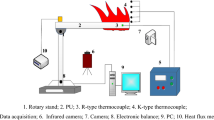Abstract
Closing the coal mine and injecting nitrogen, as a common fire fighting method, will form a high pressure and low oxygen environment in the closed coal mine. To investigate the fire risk of the rigid polyurethane (PU) foam under this environment, a series of experiments were carried out in the self-designed device. In the experiments, the oxygen concentration (pressure) changed from \({21}\%\, ({0.101}\,{\hbox {MPa}})\) to \({16}\,{\%}\, ({0.133}\,{\hbox {MPa}})\), and the material thickness varied between \({3}\,{\hbox {cm}}, {4}\,{\hbox {cm}}\) and \({5}\,{\hbox {cm}}\). PU’s flame speed, flame height and gas-phase temperature were obtained and analyzed from different aspects. The experimental results are as follows: (1) The effect of oxygen concentration reduction was stronger than that of pressure increase on flame speed. The critical heat flux of vertical flame propagation and the volume of carbon skeleton structure, which were influenced by the material thickness, affected the flame speed. (2) Under the influence of oxygen concentration and buoyancy of mixed gas in closed area, the normalized flame height showed a unique variation rule. (3) The final absolute pressure in the experimental equipment could be compared with the initial pressure to show the insufficiency of combustion. The maximum gas-phase temperature at \({3}\,{\hbox {cm}}\) above the fuel surface showed different variation patterns, when the average optical density of soot particles were on the two sides with 200 (dimensionless number). The results illustrate that in the high pressure and low oxygen environment, reducing the oxygen concentration rapidly is the key to extinguishing the coal mine fire, although the increase in pressure will enhance the intensity of combustion.














Similar content being viewed by others
References
Dong J (2009) Analysis on harm and preventive measure of coal mine fire. Shanxi Coking Coal Science & Technology, Taiyuan
Blasi CD, Crescitelli S, Russo G (1988) Near limit flame spread over thick fuels in a concurrent forced flow. Combust Flame 72(2):205
Loh HT, Fernandez-Pello AC (1985) A study of the controlling mechanisms of flow assisted flame spread. Symp Combust 20(1):1575
Magee R, Mcalevy I (1971) The mechanism of flame spread. J Bacteriol 43(72): 827
Frey AE Jr, T’Ien JS (1979) A theory of flame spread over a solid fuel including finite-rate chemical kinetics. Combust Flame 36:263
Altenkirch RA, Eichhorn R, Shang PC (1980) Buoyancy effects on flames spreading down thermally thin fuels. Combust Flame 37(1):71
Frey AE Jr, T’Ien JS (1976) Near-limit flame spread over paper samples. Combust Flame 26(2):257
Kleinhenz J, Feier II, Hsu SY, T’Ien JS, Ferkul PV, Sacksteder KR (2008) Pressure modeling of upward flame spread and burning rates over solids in partial gravity. Combust Flame 154(4):637
Wieser D, Jauch P, Willi U (1997) The influence of high altitude on fire detector test fires. Fire Saf J 29(2):195
Wang WG (2004) Experimental studies on flame spread across thermally thin solid fuel surfaces under lower ambient pressures. J Eng Thermophys 25(5):887
Du W, Hu W (2003) Effect of ambient pressure and radiation reabsorption of atmosphere on the flame spreading over thermally thin combustibles in microgravity. Sci China Technol Sci 46(4):381
McAlevy RF, Magee RS (1969) The mechanism of flame spreading over the surface of igniting condensed-phase materials. Symp Combust 12(1):215
Zhen-Hua LI, Yang MJ, Zhang H, Wang J (2009) Contrastive experiments and combustion characteristics of a square-pans fire under low pressure and low oxygen concentration in Tibet. J Univ Sci Technol China 2:018
Xu B (2010) Investigation of improving fatigue strength of welded joints. Ph.D. thesis, University of Science and Technology of China
Huang XJ, Sun JH, Ji J Zhang Y, Wang QS, Zhang Y (2011) Flame spread over the surface of thermal insulation materials in different environments. Chin Sci Bull 56(15):1617
Hao J, Song HY, Liu SP (2000) Application of polyurethane in hydro-engineering. J Yangtze River Sci Res Inst 17(6): 70–72,75
De Ris J (1969) Spread of a laminar diffusion flame. Symp Combust 12(1):241
DiNenno PJ (2008) SFPE handbook of fire protection engineering (SFPE)
Yang M (2011) Experimental and computational study on the effects of low atmospheric pressure on the gas fuel combustion char-acteristics and smoke properties under high altitudes. Ph.D. thesis, University of Science and Technology of China
Zukoski EE, Cetegen BM, Kubota T (1985) In: Symposium (international) on combustion, pp 361–366
Liousse C, Cachier H, Jennings SG (1993) Optical and thermal measurements of black carbon aerosol content in different environments: variation of the specific attenuation cross-section, sigma (\(\sigma \)). Atmos Environ A Gen Top 27(8):1203–1211
Chao L (2012) Studies on soot formation and morphology in ethylene-oxygen enriched laminar diffusion flame by thermophoretic sampling. Ph.D. thesis, Huazhong University of Science & Technology (2012)
Fan WD, Xie GL, Xu B, Yu J, Zhang MC (2005) Thermogravimetric study of the effect of oxygen concentrations on combustion characteristics of natural gas soot. J Fuel Chem Technol 74(1):127
Yong E, Song GL, Zhang Y, Wang XM (2006) Environmental effects of particulate matter of black carbon. Earth Environ 34(1):61
De Ris J (1979) Fire radiation a review. Symp Combust 17(1):1003
Author information
Authors and Affiliations
Corresponding author
Additional information
Publisher's Note
Springer Nature remains neutral with regard to jurisdictional claims in published maps and institutional affiliations.
Rights and permissions
About this article
Cite this article
Ma, Y., Du, W., Wu, B. et al. Experimental Study on the Combustion Characteristics of Polyurethane Under High Pressure and Low Oxygen Environment. Fire Technol 55, 915–934 (2019). https://doi.org/10.1007/s10694-018-00812-6
Received:
Accepted:
Published:
Issue Date:
DOI: https://doi.org/10.1007/s10694-018-00812-6




